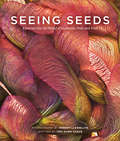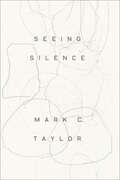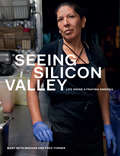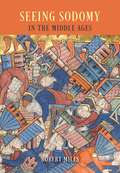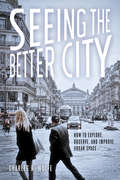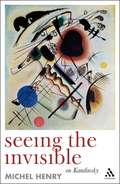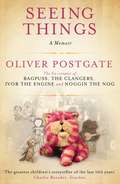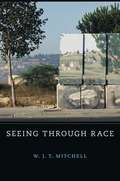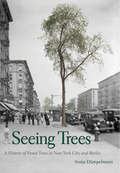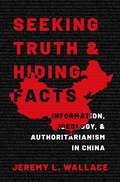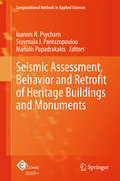- Table View
- List View
Seeing Seeds: A Journey into the World of Seedheads, Pods, and Fruit (Seeing Series)
by Teri Dunn Chace Robert LlewellynTeri Dunn Chace's remarkable horticultural insights and Robert Llewellyn&’s breathtaking photographs make this addition to the Timber Press Seeing Series a fascinating exploration of seeds, seedheads, pods, and fruits to bring you into a closer, more intimate relationship with these miracles of nature.
Seeing Silence
by Mark C. Taylor“To hear silence is to find stillness in the midst of the restlessness that makes creative life possible and the inescapability of death acceptable.” So writes Mark C. Taylor in his latest book, a philosophy of silence for our nervous, chattering age. How do we find silence—and more importantly, how do we understand it—amid the incessant buzz of the networks that enmesh us? Have we forgotten how to listen to each other, to recognize the virtues of modesty and reticence, and to appreciate the resonance of silence? Are we less prepared than ever for the ultimate silence that awaits us all? Taylor wants us to pause long enough to hear what is not said and to attend to what remains unsayable. In his account, our way to hearing silence is, paradoxically, to see it. He explores the many variations of silence by considering the work of leading modern and postmodern visual artists, including Barnett Newman, Ad Reinhardt, James Turrell, and Anish Kapoor. Developing the insights of philosophers, theologians, writers, and composers, Taylor weaves a rich narrative modeled on the Stations of the Cross. His chapter titles suggest our positions toward silence: Without. Before. From. Beyond. Against. Within. Between. Toward. Around. With. In. Recasting Hegel’s phenomenology of spirit and Kierkegaard’s stages on life’s way, Taylor translates the traditional Via Dolorosa into a Nietzschean Via Jubilosa that affirms light in the midst of darkness. Seeing Silence is a thoughtful meditation that invites readers to linger long enough to see silence, and, in this way, perhaps to hear once again the wordless Word that once was named “God.”
Seeing Silicon Valley: Life inside a Fraying America
by Mary Beth Meehan Fred TurnerAcclaimed photographer Mary Beth Meehan and Silicon Valley culture expert Fred Turner join forces to give us an unseen view of the heart of the tech world. It’s hard to imagine a place more central to American mythology today than Silicon Valley. To outsiders, the region glitters with the promise of extraordinary wealth and innovation. But behind this image lies another Silicon Valley, one segregated by race, class, and nationality in complex and contradictory ways. Its beautiful landscape lies atop underground streams of pollutants left behind by decades of technological innovation, and while its billionaires live in compounds, surrounded by redwood trees and security fences, its service workers live in their cars. With arresting photography and intimate stories, Seeing Silicon Valley makes this hidden world visible. Instead of young entrepreneurs striving for efficiency in minimalist corporate campuses, we see portraits of struggle—families displaced by an impossible real estate market, workers striving for a living wage, and communities harmed by environmental degradation. If the fate of Silicon Valley is the fate of America—as so many of its boosters claim—then this book gives us an unvarnished look into the future.
Seeing Silicon Valley: Life inside a Fraying America
by Mary Beth Meehan Fred TurnerAcclaimed photographer Mary Beth Meehan and Silicon Valley culture expert Fred Turner join forces to give us an unseen view of the heart of the tech world. It’s hard to imagine a place more central to American mythology today than Silicon Valley. To outsiders, the region glitters with the promise of extraordinary wealth and innovation. But behind this image lies another Silicon Valley, one segregated by race, class, and nationality in complex and contradictory ways. Its beautiful landscape lies atop underground streams of pollutants left behind by decades of technological innovation, and while its billionaires live in compounds, surrounded by redwood trees and security fences, its service workers live in their cars. With arresting photography and intimate stories, Seeing Silicon Valley makes this hidden world visible. Instead of young entrepreneurs striving for efficiency in minimalist corporate campuses, we see portraits of struggle—families displaced by an impossible real estate market, workers striving for a living wage, and communities harmed by environmental degradation. If the fate of Silicon Valley is the fate of America—as so many of its boosters claim—then this book gives us an unvarnished look into the future.
Seeing Sodomy in the Middle Ages
by Robert MillsDuring the Middle Ages in Europe, some sexual and gendered behaviors were labeled “sodomitical” or evoked the use of ambiguous phrases such as the “unmentionable vice” or the “sin against nature.” How, though, did these categories enter the field of vision? How do you know a sodomite when you see one? In Seeing Sodomy in the Middle Ages, Robert Mills explores the relationship between sodomy and motifs of vision and visibility in medieval culture, on the one hand, and those categories we today call gender and sexuality, on the other. Challenging the view that ideas about sexual and gender dissidence were too confused to congeal into a coherent form in the Middle Ages, Mills demonstrates that sodomy had a rich, multimedia presence in the period—and that a flexible approach to questions of terminology sheds new light on the many forms this presence took. Among the topics that Mills covers are depictions of the practices of sodomites in illuminated Bibles; motifs of gender transformation and sex change as envisioned by medieval artists and commentators on Ovid; sexual relations in religious houses and other enclosed spaces; and the applicability of modern categories such as “transgender,” “butch” and “femme,” or “sexual orientation” to medieval culture. Taking in a multitude of images, texts, and methodologies, this book will be of interest to all scholars, regardless of discipline, who engage with gender and sexuality in their work.
Seeing Sodomy in the Middle Ages
by Robert MillsDuring the Middle Ages in Europe, some sexual and gendered behaviors were labeled “sodomitical” or evoked the use of ambiguous phrases such as the “unmentionable vice” or the “sin against nature.” How, though, did these categories enter the field of vision? How do you know a sodomite when you see one? In Seeing Sodomy in the Middle Ages, Robert Mills explores the relationship between sodomy and motifs of vision and visibility in medieval culture, on the one hand, and those categories we today call gender and sexuality, on the other. Challenging the view that ideas about sexual and gender dissidence were too confused to congeal into a coherent form in the Middle Ages, Mills demonstrates that sodomy had a rich, multimedia presence in the period—and that a flexible approach to questions of terminology sheds new light on the many forms this presence took. Among the topics that Mills covers are depictions of the practices of sodomites in illuminated Bibles; motifs of gender transformation and sex change as envisioned by medieval artists and commentators on Ovid; sexual relations in religious houses and other enclosed spaces; and the applicability of modern categories such as “transgender,” “butch” and “femme,” or “sexual orientation” to medieval culture. Taking in a multitude of images, texts, and methodologies, this book will be of interest to all scholars, regardless of discipline, who engage with gender and sexuality in their work.
Seeing Sodomy in the Middle Ages
by Robert MillsDuring the Middle Ages in Europe, some sexual and gendered behaviors were labeled “sodomitical” or evoked the use of ambiguous phrases such as the “unmentionable vice” or the “sin against nature.” How, though, did these categories enter the field of vision? How do you know a sodomite when you see one? In Seeing Sodomy in the Middle Ages, Robert Mills explores the relationship between sodomy and motifs of vision and visibility in medieval culture, on the one hand, and those categories we today call gender and sexuality, on the other. Challenging the view that ideas about sexual and gender dissidence were too confused to congeal into a coherent form in the Middle Ages, Mills demonstrates that sodomy had a rich, multimedia presence in the period—and that a flexible approach to questions of terminology sheds new light on the many forms this presence took. Among the topics that Mills covers are depictions of the practices of sodomites in illuminated Bibles; motifs of gender transformation and sex change as envisioned by medieval artists and commentators on Ovid; sexual relations in religious houses and other enclosed spaces; and the applicability of modern categories such as “transgender,” “butch” and “femme,” or “sexual orientation” to medieval culture. Taking in a multitude of images, texts, and methodologies, this book will be of interest to all scholars, regardless of discipline, who engage with gender and sexuality in their work.
Seeing Sodomy in the Middle Ages
by Robert MillsDuring the Middle Ages in Europe, some sexual and gendered behaviors were labeled “sodomitical” or evoked the use of ambiguous phrases such as the “unmentionable vice” or the “sin against nature.” How, though, did these categories enter the field of vision? How do you know a sodomite when you see one? In Seeing Sodomy in the Middle Ages, Robert Mills explores the relationship between sodomy and motifs of vision and visibility in medieval culture, on the one hand, and those categories we today call gender and sexuality, on the other. Challenging the view that ideas about sexual and gender dissidence were too confused to congeal into a coherent form in the Middle Ages, Mills demonstrates that sodomy had a rich, multimedia presence in the period—and that a flexible approach to questions of terminology sheds new light on the many forms this presence took. Among the topics that Mills covers are depictions of the practices of sodomites in illuminated Bibles; motifs of gender transformation and sex change as envisioned by medieval artists and commentators on Ovid; sexual relations in religious houses and other enclosed spaces; and the applicability of modern categories such as “transgender,” “butch” and “femme,” or “sexual orientation” to medieval culture. Taking in a multitude of images, texts, and methodologies, this book will be of interest to all scholars, regardless of discipline, who engage with gender and sexuality in their work.
Seeing the Better City: How to Explore, Observe, and Improve Urban Space
by Charles R. WolfeThis volume brings our attention back to the real world right in front of us, focusing it once more on the sights, sounds, and experiences of place in order to craft policies, plans, and regulations to shape better urban environments.
Seeing the Invisible: On Kandinsky
by Michel Henry Scott DavidsonMichel Henry was one of the leading French philosophers of the twentieth century. His numerous works of philosophy are all organized around the theme of life. In contrast to the scientific understanding of life as a biological process, Henry's philosophy develops a conception of life as an immediate feeling of one's own living. Seeing the Invisible marks Henry's most sustained engagement in the field of aesthetics. Through an analysis of the life and works of Wassily Kandinsky, Henry uncovers the philosophical significance of Kandinsky's revolution in painting: that abstract art reveals the invisible essence of life. Henry shows that Kandinsky separates color and line from the constraints of visible form and, in so doing, conveys the invisible intensity of life. More than just a study of art history, this book presents Kandinsky as an artist who is engaged in the project of painting the invisible and thus offers invaluable methodological clues for Henry's own phenomenology of the invisible.
Seeing Things: A Memoir
by Oliver Postgate Stephen Fry Daniel PostgateOliver Postgate is widely regarded as the greatest children's storyteller of the modern era. His work, which included The Clangers, Ivor the Engine, The Pogles, Noggin the Nog and, most famously, Bagpuss, is beloved by generations. In this delicious memoir Oliver Postgate describes how he came to create his stories and characters, developing innovative techniques of animation and puppetry alongside his friend and co-producer Peter Firmin. Amazingly, almost all of Oliver's films were made in a cowshed in Kent on a budget of next to nothing. The story of Oliver Postgate's extraordinary and adventurous life, and the wonderful characters who populated it - both real and imagined - is witty, charming, beautifully remembered and exquisitely told.
Seeing Things (PDF): A Memoir
by Oliver Postgate Stephen Fry Daniel PostgateOliver Postgate is widely regarded as the greatest children's storyteller of the modern era. His work, which included The Clangers, Ivor the Engine, The Pogles, Noggin the Nog and, most famously, Bagpuss, is beloved by generations. In this delicious memoir Oliver Postgate describes how he came to create his stories and characters, developing innovative techniques of animation and puppetry alongside his friend and co-producer Peter Firmin. Amazingly, almost all of Oliver's films were made in a cowshed in Kent on a budget of next to nothing. The story of Oliver Postgate's extraordinary and adventurous life, and the wonderful characters who populated it - both real and imagined - is witty, charming, beautifully remembered and exquisitely told.
Seeing Through Race (The\w. E. B. Du Bois Lectures #11)
by W. J. MitchellAccording to Mitchell, a “color-blind” post-racial world is neither achievable nor desirable. Against claims that race is an outmoded construct, he contends that race is not simply something to be seen but is a fundamental medium through which we experience human otherness. Race also makes racism visible and is thus our best weapon against it.
Seeing Through Race (The\w. E. B. Du Bois Lectures #11)
by W. J. MitchellAccording to Mitchell, a “color-blind” post-racial world is neither achievable nor desirable. Against claims that race is an outmoded construct, he contends that race is not simply something to be seen but is a fundamental medium through which we experience human otherness. Race also makes racism visible and is thus our best weapon against it.
Seeing Through the Seventies: Essays on Feminism and Art (Critical Voices In Art, Theory, Culture Ser.)
by Laura CottinghamIn recent years, Laura Cottingham has emerged as one of the most visible feminist critics of the so-called post-feminist generation. Following a social-political approach to art history and criticism that accepts visual culture as part of a larger social reality, Cottingham's writings investigate central tensions currently operative in the production, distribution and evaluation of art, especially those related to cultural production by and about women.Seeing Through the Seventies: Essays on Feminism and Art gathers together Cottingham's key essays from the 1990's. These include an appraisal of Lucy R. Lippard, the most influential feminist art critic of the1970's; a critique of the masculinist bias implicit to modernism and explicitly recuperated by commercially successful artists during the 1980s; an exhaustive analysis of the curatorial failures operative in the "Bad Girls" museum exhibitions of the early 1990s; surveys of feminist-influenced art practices during the women's liberationist period; speculations on the current possibilities and obstacles that attend efforts to recover lesbian cultural history; and an examination of the life, work and obscuration of the early twentieth-century French photographer Claude Cahun.
Seeing Through the Seventies: Essays on Feminism and Art
by Laura CottinghamIn recent years, Laura Cottingham has emerged as one of the most visible feminist critics of the so-called post-feminist generation. Following a social-political approach to art history and criticism that accepts visual culture as part of a larger social reality, Cottingham's writings investigate central tensions currently operative in the production, distribution and evaluation of art, especially those related to cultural production by and about women.Seeing Through the Seventies: Essays on Feminism and Art gathers together Cottingham's key essays from the 1990's. These include an appraisal of Lucy R. Lippard, the most influential feminist art critic of the1970's; a critique of the masculinist bias implicit to modernism and explicitly recuperated by commercially successful artists during the 1980s; an exhaustive analysis of the curatorial failures operative in the "Bad Girls" museum exhibitions of the early 1990s; surveys of feminist-influenced art practices during the women's liberationist period; speculations on the current possibilities and obstacles that attend efforts to recover lesbian cultural history; and an examination of the life, work and obscuration of the early twentieth-century French photographer Claude Cahun.
Seeing Trees: A History of Street Trees in New York City and Berlin (Seeing Ser.)
by Sonja DümpelmannA fascinating and beautifully illustrated volume that explains what street trees tell us about humanity’s changing relationship with nature and the city Today, cities around the globe are planting street trees to mitigate the effects of climate change. However, as landscape historian Sonja Dümpelmann explains, the planting of street trees in cities to serve specific functions is not a new phenomenon. In her eye-opening work, Dümpelmann shows how New York City and Berlin began systematically planting trees to improve the urban climate during the nineteenth century, presenting the history of the practice within its larger social, cultural, and political contexts. A unique integration of empirical research and theory, Dümpelmann’s richly illustrated work uncovers this important untold story. Street trees—variously regarded as sanitizers, nuisances, upholders of virtue, economic engines, and more—reflect the changing relationship between humans and nonhuman nature in urban environments. Offering valuable insights and frameworks, this authoritative volume will be an important resource for years to come.
Seeking Truth and Hiding Facts: Information, Ideology, and Authoritarianism in China
by Jeremy L. WallaceA unique analysis of the numbers that came to define Chinese politics and how this quantification evolved over time. For decades, a few numbers came to define Chinese politics-until those numbers did not count what mattered and what they counted did not measure up. Seeking Truth and Hiding Facts argues that the Chinese government adopted a system of limited, quantified vision in order to survive the disasters unleashed by Mao Zedong's ideological leadership. Jeremy Wallace explains how that system worked and analyzes how the problems that accumulated in its blind spots led Xi Jinping to take drastic action. Xi's neopolitical turn--aggressive anti-corruption campaigns, reassertion of party authority, and personalization of power--is an attempt fix the problems of the prior system, as well as a hedge against an inability to do so. The book argues that while of course dictators stay in power through coercion and cooptation, they also do so by convincing their populations and themselves of their right to rule. Quantification is one tool in this persuasive arsenal, but it comes with its own perils.
Seeking Truth and Hiding Facts: Information, Ideology, and Authoritarianism in China
by Jeremy L. WallaceA unique analysis of the numbers that came to define Chinese politics and how this quantification evolved over time. For decades, a few numbers came to define Chinese politics-until those numbers did not count what mattered and what they counted did not measure up. Seeking Truth and Hiding Facts argues that the Chinese government adopted a system of limited, quantified vision in order to survive the disasters unleashed by Mao Zedong's ideological leadership. Jeremy Wallace explains how that system worked and analyzes how the problems that accumulated in its blind spots led Xi Jinping to take drastic action. Xi's neopolitical turn--aggressive anti-corruption campaigns, reassertion of party authority, and personalization of power--is an attempt fix the problems of the prior system, as well as a hedge against an inability to do so. The book argues that while of course dictators stay in power through coercion and cooptation, they also do so by convincing their populations and themselves of their right to rule. Quantification is one tool in this persuasive arsenal, but it comes with its own perils.
Segmentation and Recovery of Superquadrics (Computational Imaging and Vision #20)
by Ales Jaklic Ales Leonardis F. SolinaA representation of objects by their parts is the dominant strategy for representing complex 3D objects in many disciplines. In computer vision and robotics, superquadrics are among the most widespread part models. Superquadrics are a family of parametric models that cover a wide variety of smoothly changing 3D symmetric shapes, which are controlled with a small number of parameters and which can be augmented with the addition of global and local deformations. The book covers, in depth, the geometric properties of superquadrics. The main contribution of the book is an original approach to the recovery and segmentation of superquadrics from range images. Several applications of superquadrics in computer vision and robotics are thoroughly discussed and, in particular, the use of superquadrics for range image registration is demonstrated. Audience: The book is intended for readers of all levels who are familiar with and interested in computer vision issues.
Sehen und Photographie: Ästhetik und Bild (X.media.press)
by Marlene Schnelle-SchneyderWir wissen heute, dass das Sehen ein sehr komplexer Prozess ist, der zwischen Auge und Gehirn abläuft. Damit stellen sich neue Fragen an die Rezeption von Bildern. Wann und wie aktivieren Bilder unsere visuelle Wahrnehmung? Der Band enthält viele Bildbeispiele, anhand derer getestet werden kann, was wir sehen und wie wir sehen. Die aktualisierte und erweiterte Neuauflage behandelt u. a. das Thema Spiegelneuronen und diskutiert vor dem Hintergrund ihrer Entdeckung die Interaktion von Bild und Betrachter, von Nachempfindung und Emotionen.
Sehrengiz, Urban Rituals and Deviant Sufi Mysticism in Ottoman Istanbul
by B. Deniz Calis-KuralŞehrengiz is an Ottoman genre of poetry written in honor of various cities and provincial towns of the Ottoman Empire from the early sixteenth century to the early eighteenth century. This book examines the urban culture of Ottoman Istanbul through Şehrengiz, as the Ottoman space culture and traditions have been shaped by a constant struggle between conflicting groups practicing political and religious attitudes at odds. By examining real and imaginary gardens, landscapes and urban spaces and associated ritualized traditions, the book questions the formation of Ottoman space culture in relation to practices of orthodox and heterodox Islamic practices and imperial politics. The study proposes that Åžehrengiz was a subtext for secret rituals, performed in city spaces, carrying dissident ideals of Melami mysticism; following after the ideals of the thirteenth century Sufi philosopher Ibn al-’Arabi who proposed a theory of 'creative imagination' and a three-tiered definition of space, the ideal, the real and the intermediary (barzakh). In these rituals, marginal groups of guilds emphasized the autonomy of individual self, and suggested a novel proposition that the city shall become an intermediary space for reconciling the orthodox and heterodox worlds. In the early eighteenth century, liminal expressions of these marginal groups gave rise to new urban rituals, this time adopted by the Ottoman court society and by affluent city dwellers and expressed in the poetry of Nedîm. The author traces how a tradition that had its roots in the early sixteenth century as a marginal protest movement evolved until the early eighteenth century as a movement of urban space reform.
Sehrengiz, Urban Rituals and Deviant Sufi Mysticism in Ottoman Istanbul
by B. Deniz Calis-KuralŞehrengiz is an Ottoman genre of poetry written in honor of various cities and provincial towns of the Ottoman Empire from the early sixteenth century to the early eighteenth century. This book examines the urban culture of Ottoman Istanbul through Şehrengiz, as the Ottoman space culture and traditions have been shaped by a constant struggle between conflicting groups practicing political and religious attitudes at odds. By examining real and imaginary gardens, landscapes and urban spaces and associated ritualized traditions, the book questions the formation of Ottoman space culture in relation to practices of orthodox and heterodox Islamic practices and imperial politics. The study proposes that Åžehrengiz was a subtext for secret rituals, performed in city spaces, carrying dissident ideals of Melami mysticism; following after the ideals of the thirteenth century Sufi philosopher Ibn al-’Arabi who proposed a theory of 'creative imagination' and a three-tiered definition of space, the ideal, the real and the intermediary (barzakh). In these rituals, marginal groups of guilds emphasized the autonomy of individual self, and suggested a novel proposition that the city shall become an intermediary space for reconciling the orthodox and heterodox worlds. In the early eighteenth century, liminal expressions of these marginal groups gave rise to new urban rituals, this time adopted by the Ottoman court society and by affluent city dwellers and expressed in the poetry of Nedîm. The author traces how a tradition that had its roots in the early sixteenth century as a marginal protest movement evolved until the early eighteenth century as a movement of urban space reform.
Seinfeld, Master of Its Domain: Revisiting Television's Greatest Sitcom
by David Lavery Sara Lewis DunneAfter a slow and inauspicious beginning, Seinfeld broke through to become one of the most commercially successful sitcoms in the history of television. This fascinating book includes classic articles on the show by Geoffrey O'Brien and Bill Wyman (first published in the New York Review of Books and Salon.com respectively), and a selection of new and revised essays by some of the top television scholars in the US - looking at issues as wide-ranging as Seinfeld's Jewishness, alleged nihilism, food obsession, and long-running syndication. The book also includes a comprehensive episode guide, and Betty Lee's lexicon of Seinfeld language.
Seismic Assessment, Behavior and Retrofit of Heritage Buildings and Monuments (Computational Methods in Applied Sciences #37)
by Ioannis N. Psycharis Stavroula J. Pantazopoulou Manolis PapadrakakisThis book assembles, identifies and highlights the most recent developments in Rehabilitation and retrofitting of historical and heritage structures. This is an issue of paramount importance in countries with great built cultural heritage that also suffer from high seismicity, such as the countries of the eastern Mediterranean basin. Heritage structures range from traditional residential constructions to monumental structures, ancient temples, towers, castles, etc. It is generally recognized that these structures present particular difficulties in seismic response calculation through computer simulation due to the complexity of the structural system which is, generally, inhomogeneous, with several contact problems, gaps/joints, nonlinearities and brittleness in material constituents. This book contains selected papers from the ECCOMAS Thematic Conferences on Computational Methods in Structural Dynamics & Earthquake Engineering (COMPDYN) that were held in Corfu, Greece in 2011 and Kos, Greece in 2013. The Conferences brought together the scientific communities of Computational Mechanics, Structural Dynamics and Earthquake Engineering in an effort to facilitate the exchange of ideas in topics of mutual interest and to serve as a platform for establishing links between research groups with complementary activities.
